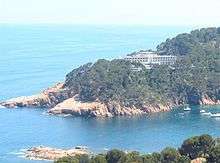Parador

A parador (Spanish pronunciation: [paɾaˈðor]), in Spain and other Spanish-speaking countries, is a kind of luxury hotel, usually located in a converted historic building such as a monastery or castle. Parar means to stop, halt or stay.
Tourism Paradores in Spain
Paradores de Turismo de España is a chain of Spanish luxury hotels. The enterprise was founded by Alfonso XIII of Spain as a means to promote tourism in Spain, with the first hotel opening in 1928 in Gredos, Ávila. This state-run business has been profitable. The hotels are often located in adapted castles, palaces, fortresses, convents, monasteries and other historic buildings. They add to the attractions of heritage tourism and provide uses for large historic buildings. The Hostal de los Reyes Catolicos in Santiago de Compostela is considered to be one of the oldest continuously operating hotels in the world, and one of the finest Spanish paradors.
They are located from Galicia in the north-west through Catalonia to Andalusia in the south of Spain, and the Canary Islands. Paradors are also located in some former colonial Spanish cities in North African nations. Prices usually vary according to room, region and season.
Paradors are classified as 'Esentia' - monumental and historic hotels, 'Civia' - urban hotels, and 'Naturia' - hotels close to the coast and nature. Ninety-four Paradors are located in Spain (listed below) and one, Casa da Ínsua, in Portugal. The Portuguese equivalent, the Pousadas de Portugal, were founded in 1942, after the Spanish model.
List of Paradors: Parador, Classification (Province)
- Aiguablava, Naturia (Girona)
- Alarcón, Esentia (Cuenca)
- Albacete, Civia (Albacete)
- Alcalá de Henares, Civia (Madrid)
- Alcañiz, Esentia (Teruel)
- Almagro, Esentia (Ciudad Real)
- Antequera, Civia (Málaga)
- Arcos de la Frontera, Esentia (Cádiz)
- Argómaniz, Civia (Álava)
- Artíes, Naturia (Lleida)
- Ávila, Esentia (Ávila)
- Ayamonte, Naturia (Huelva)
- Baiona, Esentia (Pontevedra)
- Benavente, Civia (Zamora)
- Benicarló, Naturia (Castellón)
- Bielsa, Naturia (Huesca)
- Cáceres, Esentia (Cáceres)
- Cádiz, Civia (Cádiz)
- Calahorra, Civia (La Rioja)
- Cambados, Naturia (Pontevedra)
- Cangas de Onís, Naturia (Asturias)
- Cardona, Esentia (Barcelona)
- Carmona, Esentia (Sevilla)
- Cazorla, Naturia (Jaén)
- Cervera de Pisuerga, Naturia (Palencia)
- Ceuta, Civia (Autonomous city of Ceuta)
- Chinchón, Esentia (Madrid)
- Ciudad Rodrigo, Esentia (Salamanca)
- Córdoba, Civia (Córdoba)
- Corias, Esentia (Asturias)
- Cruz de Tejeda, Naturia (Las Palmas)
- Cuenca, Esentia (Cuenca)
- El Hierro, Naturia (Santa Cruz de Tenerife)
- El Saler, Naturia (Valencia)
- Ferrol, Civia (A Coruña)
- Fuente Dé, Naturia (Cantabria)
- Gijón, Civia (Asturias)
- Granada, Esentia (Granada)
- Gredos, Naturia (Ávila)
- Guadalupe, Esentia (Cáceres)
- Hondarribia, Esentia (Guipúzcoa)
- Jaén, Esentia (Jaén)
- Jarandilla de la Vera, Esentia (Cáceres)
- Jávea, Naturia (Alicante)
- La Gomera, Naturia (Santa Cruz de Tenerife)
- La Granja, Esentia (Segovia)
- La Palma, Naturia (Santa Cruz de Tenerife)
- La Seu d’Urgell, Civia (Lleida)
- Las Cañadas del Teide, Naturia (Santa Cruz de Tenerife)
- León, Esentia (León)
- Lerma, Esentia (Burgos)
- Limpias, Naturia (Cantabria)
- Lorca, Esentia (Murcia)
- Málaga Gibralfaro, Civia (Málaga)
- Málaga Golf, Naturia (Málaga)
- Manzanares, Civia (Ciudad Real)
- Mazagón, Naturia (Huelva)
- Melilla, Civia (Autonomous city of Melilla)
- Mérida, Esentia (Badajoz)
- Mojácar, Naturia (Almería)
- Monforte de Lemos, Esentia (Lugo)
- Nerja, Naturia (Málaga)
- Olite, Esentia (Navarra)
- Oropesa, Esentia (Toledo)
- Plasencia, Esentia (Cáceres)
- Pontevedra, Civia (Pontevedra)
- Puebla de Sanabria, Naturia (Zamora)
- Ribadeo, Naturia (Lugo)
- Ronda, Esentia (Málaga)
- Salamanca, Civia (Salamanca)
- Santiago de Compostela, Esentia (A Coruña)
- Santillana del Mar, Esentia (Cantabria)
- Santillana Gil Blas, Esentia (Cantabria)
- Santo Domingo Bernardo de Fresneda, Esentia (La Rioja)
- Santo Domingo de la Calzada, Esentia (La Rioja)
- Santo Estevo, Esentia (Ourense)
- Segovia, Civia (Segovia)
- Sigüenza, Esentia (Guadalajara)
- Soria, Civia (Soria)
- Sos del Rey Católico, Esentia (Zaragoza)
- Teruel, Civia (Teruel)
- Toledo, Esentia (Toledo)
- Tordesillas, Civia (Valladolid)
- Tortosa, Esentia (Tarragona)
- Trujillo, Esentia (Cáceres)
- Tui, Civia (Pontevedra)
- Úbeda, Esentia (Jaén)
- Verín, Esentia (Ourense)
- Vic-Sau, Naturia (Barcelona)
- Vielha, Naturia (Lleida)
- Vilalba, Civia (Lugo)
- Villafranca del Bierzo, Naturia (León)
- Zafra, Esentia (Badajoz)
- Zamora, Esentia (Zamora)
Paradores of Puerto Rico
The Puerto Rico Tourism Company was established during the early 1970s under the administration of Governor Luis A. Ferre, who wanted to enhance the tourism sector of the island. The company runs an enterprise known as Paradores de Puerto Rico; these are typically small, one-of-a-kind, locally owned and operated hotels located in rural areas throughout the island commonwealth. They are frequented by guests looking to enjoy the local customs and charm. Often called "country inns" in English, paradores in Puerto Rico are usually located in rural areas.
To be part of the Paradores de Puerto Rico Program, the hotel must meet certain standards set by the Puerto Rico Tourism Company. These include being located outside the San Juan metro area (most of them are located on the west coast or in the mountains), having 15 to 75 rooms, having a restaurant on site or nearby, and being family-owned and operated.
See also
References
External links
| Wikimedia Commons has media related to Paradores de Turismo. |
- The Parador in Ronda, Andalucia
- (Spanish) (English) Paradores de Turismo de España
- US representative of the Paradores
- Official UK representative of the paradors
- Flickr group with photos of paradors
- (English) Paradores de Puerto Rico